Austin armoured cars
Part I: Development and construction / The Russian service
|
|
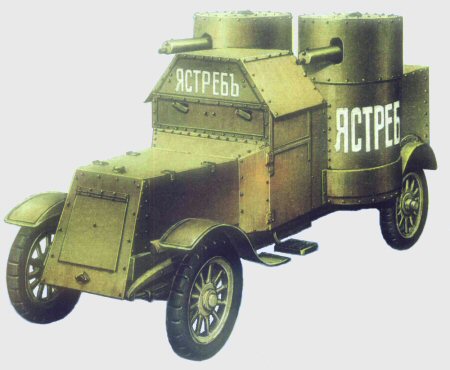 |
Russian Austin the 1st series, named "Yastreb" (Hawk) of the 9th auto-MG platoon
[Mikhail Dimitrev, 5] |
One of most significant armoured cars of the First World War period was the British-designed Austin armoured car. Built in several variants, Austin was the basic armoured car of the tsarist Russian Army, then it was the most numerous car used by all sides in the civil war in Russia, mostly by the Soviets. Unlike a trench war on the Western Front, conditions on the East made possible manoeuvre operations, and armoured cars played much more important role there, comparable to tanks. A number of Austin armoured cars were also used by the British, taking part in 1918 Western Front combat. Captured Austins were used by several other armies. Their service in the Polish Army is described in detail in the Part II.
History and development of Austin armoured cars:
British-built Austins:
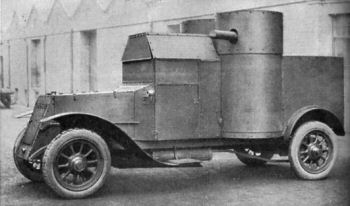 |
|---|
| Austin the 1st series in a basic configuration. [4] |
| |
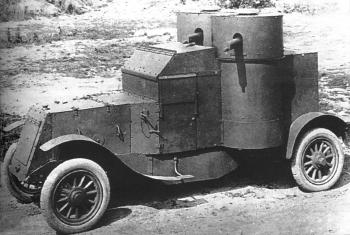 |
|---|
| Austin the 2nd series (in an original British configuration, without Russian modifications). [1,5] |
The story of Austin armoured cars began just after the outbreak of the Great War, in August 1914, when the Russian government decided to order a number of military cars including armoured cars abroad, due to limited own production capabilities. Russians demanded, that an armoured car should have twin turrets with machine guns and a full armour including roof. A special committee was sent to Great Britain, but did not find any existing armoured car to meet these requirements.
In September 1914, Austin Motor Co. Ltd. in Longbridge, Birmingham, constructed a new armoured car, specially to meet Russian demands. It was armed with two machine guns in independent turrets, placed next to each other, on both sides of a hull. The Russian Army ordered 48 cars at once, and they were produced by the end of 1914. The vehicle used a chassis of a passenger car Colonial, with 30 HP engine and a rear axle driven only. They are distinguished as Austin the 1st series (or: model 1914). In a transcribed Russian spelling the car's name was: Bronyeavtomobil (armoured car) "Ostin". One car costed 1150 pound st.
The first series had some faults, most noticeable was a thin armour, vulnerable even to machine gun bullets. Just after their arrival to Russia, their armour was partially strengthened in turrets. After the first combat experience, all the vehicles were completely rebuilt by changing all their original armour plates for new, thicker 7mm plates, at Izhorski Works in Izhorsk. The armour shape remained the same. Some vehicles were also fitted with machineguns' side covers in individual units. With a new heavier armour, the engine and chassis appeared too weak, though. The car could practically ride on roads or a solid ground only (this was a shortcoming of all wheeled Austins and most contemporary armoured cars as well, anyway, with rare exceptions of off-road cars, like Jeffery-Poplavko). Despite these drawbacks of the first series, the car's construction was considered as a generally successful one. All other armoured cars bought by the Russians abroad were evaluated as worse (like Armstrong-Whitworth and Renault), or even useless (like Sheffield-Simplex and AML). This shows, that the Austin's construction must have been really successful to win Russian recognition, in spite of mentioned faults.
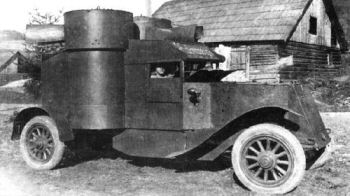 |
|---|
|
Russian modified Austin the 2nd series, name "Kavkazets" (the Caucasian) of the 46th auto-MG platoon, October 1916. [1,5] |
Because of these facts, the Russian government ordered a next batch of 60 improved vehicles, distinguished as Austin the 2nd series (or: model 1915). They were delivered from August 1915. They used stronger 1.5t truck chassis with 50 HP engine, and had thicker armour, which did not need further improvement. The hull was shortened, and a new shape of a roof above the driver did not limit a horizontal angle of fire anymore.
On the other hand, a removal of a rear hull access door was a drawback, making access more difficult, through only one side door. It was also recognized after combat experience, that armoured cars should be fitted with a second driver post for driving backwards, to improve their manoeuvrability. Therefore, soon after their arrival to Russia all vehicles of this series were modified. The visible change was an addition of a rear 'annex', triangular in cross-section. The 'annex' housed a rear driver's post, and also had an additional access doors. Apart from it, all cars were fitted with MG side shields. Some cars were equipped with a headlight on the roof, in an armoured cover. The 2nd series cars went into combat since November 1915.
In August 1916 the Russians ordered further 60 vehicles, known as Austin the 3rd series (model 1917?). This model incorporated experience from previous combat and these vehicles were produced with a rear driver post and MG side shields. A visible feature was new, 'slimer' hull shape, changed in a rear section and in a driver's cab. They had bulletproof glass in front vision slots, and big side windows were replaced with slots with raising flaps. Another distinguishing feature are rings on top of turrets' sides. All vehicles were delivered to Piotrograd (St. Petersburg) between February and summer of 1917, but few went to the front before the Bolshevik Revolution. They saw active service during the following civil war instead (most of the 3rd series cars were possesed by the bolsheviks).
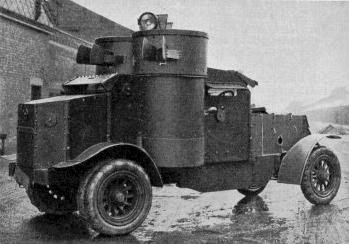 |
The Russian government ordered also another 70 improved vehicles of the 3rd series, with a strengthened chassis and double rear wheels (model 1918). However, due to political events of 1917 in Russia, not all were completed, and the completed ones were taken over by the British government. Some were used by the British Army then.
|
| The British Austin model 1918 (note double rear wheels). [4] |
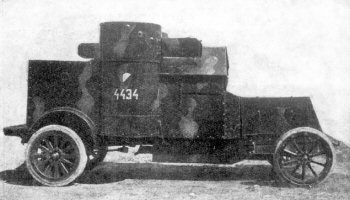 |
| The armoured car White, named "Mars", no. 4434 in the Polish service. Note bigger wheels with massive rubber rims [6] |
Apart from these production models, there existed also some non-standard cars, modified during repairs. Sometimes armoured hulls of damaged Austins were put upon other chassises - mainly White, Fiat and Packard. This practice took place mainly during the Russian civil war, when a proper maintenance was more difficult and parts were lacking.
One of chassises used in such armoured cars was 1.5 - 2t White TBC (or 3t White TC). Two such armoured cars, with bodies of Austins the 1st series, were captured by the Polish troops in 1920. They are known in Polish publications as White armoured cars (they could be distinguished more accurately as White-Austin).
Bodies of Austin the 3rd series (or similar newly built) were also put by the British Army upon Peerless chassises with a longer wheelbase. Such vehicle is preserved in Bovington Tank Museum (see at Warwheels.net).
"Russian Austins" (Austin-Putilov):
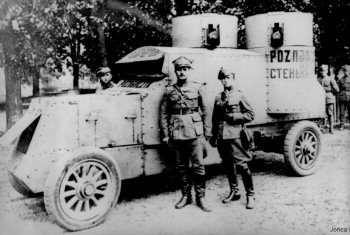 |
|---|
| The Austin-Putilov, captured by the Polish and named 'Poznanczyk' (former Soviet: 'Styenka Razin'). [AJ] |
Having gained combat experience with British-built Austins, Putilovski Works in St. Petersburg designed its own, improved type of an armoured hull, with a thicker armour. A significant feature were turrets placed diagonally in order to decrease car's width. Machine guns could also be raised for anti-aircraft fire. Such hulls were supposed to be built upon 60 chassises, ordered in Great Britain. Chassises were the same as of Austin the third series (the same, as the second series, but fitted with the rear driver post).
The first chassises were delivered with delay, in January 1917. During following months, the armouring work was very slow, due to a revolutionary chaos in the country. In the meantime, it was decided to fit all new cars with Kegresse halftrack mechanism (see below). However, this project was abandoned, and most of new armoured cars were finally completed as wheeled vehicles. The first few were built in early 1918. At last, when the manufacturing was transfered to the Izhorski Works, the series of 33 armoured cars was built from summer 1919 to spring 1920.
These cars were later distinguished in Russia as "Putilovskiy Ostin", or "Ostin-Putilovets", while the most common name in Western sources is Austin-Putilov. These names were not used in any Russian documents of that time, though - in 1918-21 they were called just "Russkiy Ostin" (Russian Austin).
One of these vehicles, named: "Vrag kapitala" - "The capital's enemy", survived in a museum in St. Petersburg. It is known as the vehicle, from which V. I. Lenin spoke in April 1917, but in fact it was manufactured in August 1919...
Austin-Kegresse:
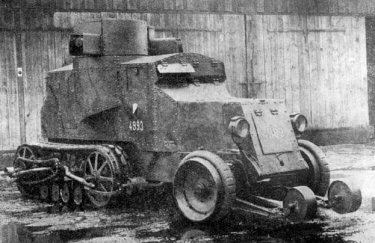 |
| Polish-captured Austin-Kegresse in the mid-twenties. [4, 6] |
Further 12 cars of Putilovski Works design were completed with Kegresse half-track drive - hence they are distinguished as Austin-Putilov-Kegresse or Austin-Kegresse.
When wheeled armoured cars went into service, it soon showed, that their weight and drive type limited their usage to roads and solid ground rather. Especially it was hard for them to move in a deep snow. That is why the Russian Army got interested in a half-track drive, which was being developed since 1909 by the chief of Tsar's garages, Adolphe Kegresse. In 1915, a batch of Packard trucks were equipped with his half-track mechanism and used as ambulances. In August 1916 one of Austins the 2nd series was experimentally fitted with Kegresse device. The proving was successful, and the car was able to ride through sandy and muddy terrain freely. As a result, 182 half-track sets were ordered. All 60 new armoured cars Austin-Putilov were to be equipped with a half-track drive. Being impressed, the Russian Staff decided even to convert succesively all Austins the 2nd series to half-tracks, and to build all newly-constructed armoured cars (among others, Fiat-Izhorski) as half-tracked ones, but it was not proceeded.
A modification of Austin chassises delayed due to a situation in the country, and only in 1919 Putilovski Works completed less than twenty half-tracked chassises. Only 12 of them were eventually completed with Putilov-design armoured hulls of Izhorski Works. The first of them started factory trials on 2 July 1919, the last were completed by March 1920. Their further production was canceled due to shortages of parts and raw materials. The produced cars were used in combat, repelling an advance of Gen. Yudenitch towards St.Petersburg, and in the Polish-Soviet war.
See unique photos of Austin-Kegresse on Polish Austins page
See a comparison drawing of Austin armoured cars.
Combat use:
In Russia - World War I:
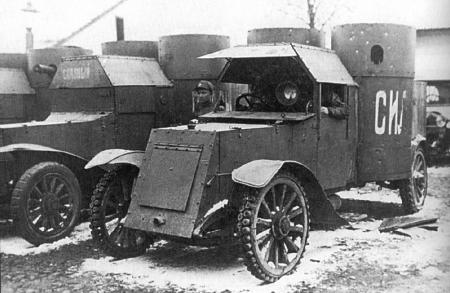 |
|---|
| Austin the 1st series cars of the 8th Auto-MG platoon. The first car, named: "Silnyi" (Strong), having the original unmodified armour, was damaged in action on 22 February 1915, near Łomża (Poland) - one of first combat actions of Austins. Bullet hollows can be seen on 7-mm turret armour, 4-mm hull armour below is pierced. The car has "combat" wheels. Another damaged Austin "Slavnyi" (Glorious) is in a background (fitted with "road" wheels). [1,5] |
From 21 December 1914 in Russia there started forming of "automobile machine gun platoons" (in Rusian: pulyemyotnyi avtomobilnyi vzvod, or in short: avtopulyemyotnyi vzvod). Initially, each platoon consisted of three Austin armoured cars, with supporting 4 staff cars, a truck, a mobile workshop, a tanker truck and 4 motorcycles, one with a sidecar (No. 19 organization chart). The platoon's crew was about 50 men. In the beginning, eight platoons were formed, numbers: 5 - 12. It is noteworthy, that Russian armoured units were organized of volunteers from other arms.
Further platoons, formed from spring 1915 introduced a new organization (No. 20), with two Austins and one gun-armed armoured car (Garford from May 1915 or Lanchester from spring 1916). Eight already existing platoons received an additional Garford to three Austins.
Auto-MG platoons were independent units of peculiar armies. In combat, they were assigned to individual divisions and regiments, according to needs. Most of platoons were used in armies of Russian Western and South-Western Fronts, but some platoons were also in the Northern Front and Caucasus Army. In 1914-1916 years 43 auto-MG platoons were formed. All used armoured cars Austin for all the time, or for some time at least. Austin armoured cars of all models were also the most numerous Russian armoured fighting vehicles. Other types of MG-armed cars, like Armstrong-Whitworth and different non-typical ones, were used in smaller quantities. Austins, especially since the 2nd series, were the best Russian MG-armed armoured cars available, anyway.
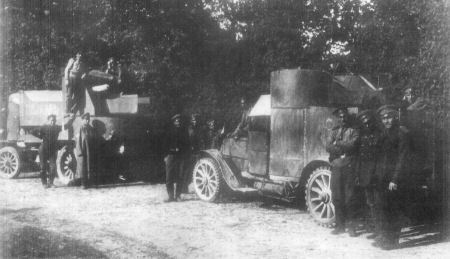 |
|---|
| Austin the 1st series and Garford (named "Pushkar"), of the 19th Auto-MG platoon, July 1916 [5] |
In 1916 it became clear, that armoured cars used in small units are not as effective, as they could be. It was especially evident during Brusilov's offensive. Consequently, in August 1916, Russian armoured units were rearranged and 12 Armoured Automobile Units (or Battalions) were formed (in Russian: Bronyevyi avtomobilnyi divizyon, avtobronyedivizyon). There was one unit per one Army (with the same numbers, as Armies). Existing platoons were included into these units and renamed to sections (otdyelenye), retaining their unit numbers. Individual units had different number of sections, varying between 2 and 5. Single platoons were still retained in Caucasus war theatre. Also the 33rd section was included into the 1st Auto-MG Company (1. Avtopulyemyotnaya rota, the first Russian armoured unit), supplementing Russo-Balt armoured cars there. From among Austins the 1st series, at least 11 were lost during the war, there is no information in publications about other series' losses.
The civil war in Russia
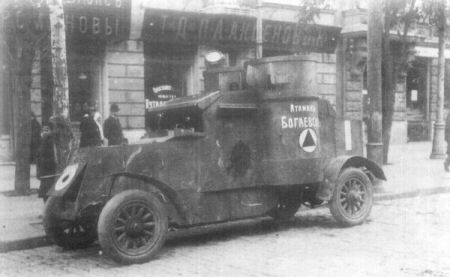 |
|---|
| Austin the 3rd series "Ataman Bogayevski" of the Don Cossack Army, 1919. A black triangle in yellow circle was a sign of the Don Cossack Army, a white-blue-red roundel on a front plate was a sign of allied white armies [5] |
After the Bolshevik Revolution in November 1917, the Austins were spread among all fronts. Starting from summer 1918, they were used by all major forces of the civil war: bolsheviks, several armies of white Russians, Cossacks, Ukrainians... The biggest share was seized by the bolsheviks (with most of the 3rd series cars, and all newly-built ones). Other forces used small numbers of cars seized during decomposition of the tsarist Army or captured later from bolsheviks. Apart from those, the British gave 6 Austins of the latest model 1918 to Denikin's white Volunteer Army (three were later captured by the bolsheviks).
Armoured cars were used in different, often improvised units at that time. From 13 November 1918, the Soviets formed as basic units avtobronyevyi otryad (avtobronyeotryad, ABO) - Armoured Automobile Units, consisting of 4 cars: 3 MG-armed cars and 1 gun-armed car (or MG-armed car), in two platoons. Supporting vehicles were 5 trucks, 4 staff cars, a tanker, a workshop truck and 4 motorcycles. The white forces usually were formed into Armoured Automobile Battalions (Bronyevyi avtomobilnyi divizyon), similar to wartime ones.
After the civil war, in 1921, the Soviets possesed approximately 16 Austins the 1st series, 15 Austins the 2nd series and 78 Austins the 3rd series and Putilovs. In the Soviet Army, the British-built Austins were withdrawn by 1931, and Austin-Putilovs and Kegresse by 1933. There is an information in some Western publications, that some Austins were allegedly modernized and survived until 1941, used by the NKVD Border Guards and as police vehicles, but Russian publications do not mention this.
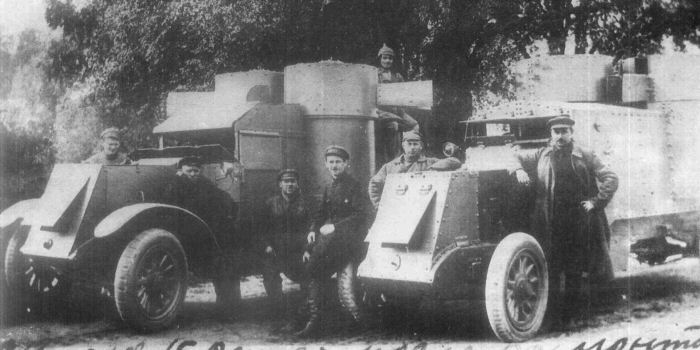 |
|---|
| Austin the 2nd series (left) and Austin-Putilov of the 1st Mounted Army, 15 September 1924. Differences between these models are visible. Note, that standard Austin-Putilovs had no front fenders [5] |
In the British Army:
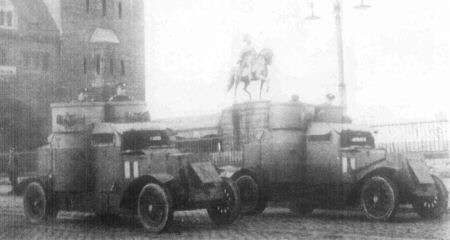 |
|---|
| British Austins model 1918 in 1918 [5] |
Some of produced Austin model 1918 armoured cars were issued to the British Tank Corps. 16 of them were sent to France around May 1918 as the 17th (Armoured Car) Battalion, Tank Corps. They were armed with 8mm Hotchkiss Mle.14 machine guns. Their first battle was on
11
June 1918 in support of the French troops. One of their most significant battles was the Battle of Amiens, on 8 August. Tanks were used to tow them over the trenches and then they broke loose and operated miles behind the German lines. They attacked the German-occupied
village of Framerville, chasing out the Germans (and nailing an
Australian flag to the front door of the German command headquarters). At least 3 cars were destroyed during the campaign. In 1919, the Austins were used by the British in a civil war in Ireland, possibly until 1921.
At least 20 cars were sent to
the Caspian Sea in February 1918 with a British unit known as
Dunsterforce, to protect oil wells at Baku against the Turks. They were operating there until November 1918, in a cooperation with the white Russians, and, at least on one occasion, with the bolsheviks (!). Only about 8 cars were actually used, partly due to mechanical problems.
Probably in 1919, at least 16 cars were sent to India. In 1921 they were used in the 8th Armoured Car Company of the Tank Corps, at least until 1923.
Some cars were used by the British in Iraq, and some of them were converted to armoured draisines (rail vehicles), after exchanging wheels. These vehicles often operated in couples, coupled with rears, so that one vehicle was used to drive the whole unit in one direction, while the other was used to drive in an opposite direction, in order to avoid slow ride on the reverse gear - a photo
Other users:
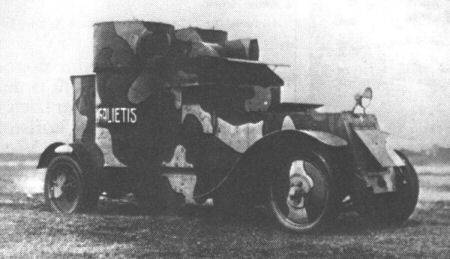 |
|---|
| The Latvian Austin the 2nd series "Zemgalietis" after modernization in the 1920s. |
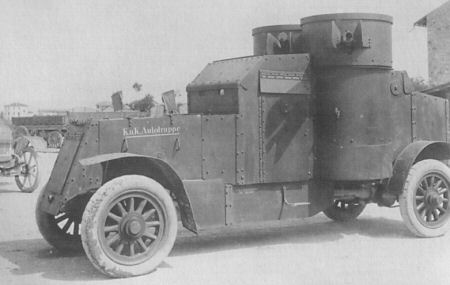 |
|---|
| A captured Austin the 3rd series in the Austro-Hungarian service during World War I. |
Some cars were captured on the Russians during the World War I or during the civil war in Russia, and next used by other countries.
- Several cars were used by the German and Austro-Hungarian armies during the First World War.
- Two Austins the 2nd series and two the 3rd series were used in the German armoured unit "Kokampf" in 1919.
- Two Austins the 3rd series were sent by the Soviets in 1918 to help the Finnish Red Guards. They fell into the Finnish governmental hands and served in the Finnish Army until the mid 1920s.
- In 1919, Estonia captured two Austin-Putilovs, and used them with names "Tasuja" and "Suur Tõll".
- Latvia used one Austin the 2nd series, named "Zemgaleetis" (later "Zemgalietis").
- One Austin the 3rd series was used in Romania.
- Two or three cars were used in the revolutionary army in Mongolia.
- Two British Austins model 1918 were sold to Japan in 1919. At least one body was later seated upon a new 3-axle chassis.
- One Austin was used in Austria until 1935.
- Poland used at least 9 - up to 20 captured Austins of all variants - see part II: armoured cars Austin in the Polish Army.
At least one Estonian or Latvian car was captured by the Soviets in 1940, and then by the Germans in 1941.
Technical description
Armament:
All Russian Austins were armed with two 7.62mm Maxim water-cooled machine guns in two turrets (on photos, there are visible Maxim model M.1905, less likely M.1910). A horizontal angle of fire was about 240° (the 1st series) and 300° (further series and Austin-Putilov). The ammunition was about 6000 rounds. The British cars used in France were armed with two 8mm Hotchkiss Mle.14 machine guns, air-cooled (the British cars used somewhere else could have Vickers MG's?).
A vertical angle of fire in Austin-Putilov and Kegresse was 80° - they could fire anti-aircraft, after shifting top covers of MG slots aside (see an example of the Polish Austin-Kegresse). A machine gun elevation in other Austin variants was low.
Austin the 3rd series, Austin-Putilov and all earlier models modified in Russia had armoured side covers of MG barrels, of several different styles.
Armour:
- Original Austin the 1st series: 3.5 - 4 mm. After their arrival to Russia their armour was partially strengthened - 7mm on turrets.
- Modified Austin the 1st series: 7 mm.
- Austin the 2nd and 3rd series: front, sides, turrets - 8 mm, top - 5 mm (?).
- Austin-Putilov: front, sides, turrets - 7.5 mm, top - 4 mm (source [1, 5]);
- front - 8 mm, sides - 6-8 mm, bottom and top - 5.5 mm, turrets - 8 mm (source [2]);
- front - 8 mm, sides - 6 mm, slanted plates - 5.5 mm, turrets - about 7.5 mm (source [3]).
According to one Russian source, the armour of original Austin 1st series was made of Cr-Ni steel, and it protected against rifle bullets from a distance above "400 footsteps", for modified vehicles - from above "75 footsteps", the same for Austin-Putilov (1 footstep might be about 1 yard).
Construction:
The construction refers to British-built Austin primarily. Other cars are marked, if different. Austin-Kegresse was identical as Austin-Putilov, apart from the drive.
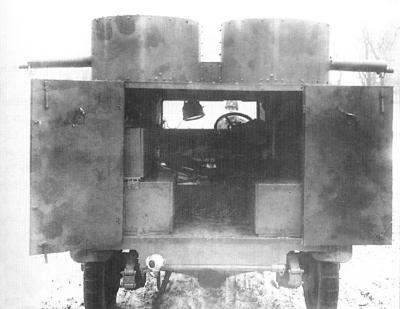 |
|---|
| An open rear doors in Austin the 1st series [1] |
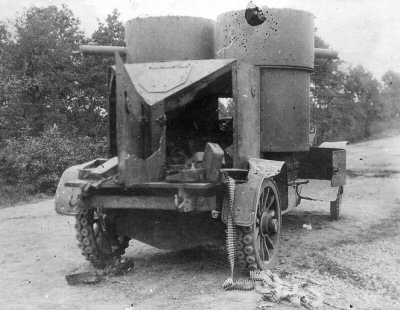 |
|---|
| An unique photo of a destroyed Austin the 2nd series, possibly near Kolomyia, July 1917. A construction of a rear "annex" is visible, with a pair of doors and an observation hatch. Also "combat" wheels and an open box for wheels below a turret are visible. |
The body was made of armour plates, screwed to a body frame. All British-built Austins had a door on the left side of the driver cab. The 1st series had also a big two-leaf door in a rear wall. Modified vehicles of the 2nd series, with the rear driver post, also had a hatch in the rear. Austin-Putilov had side doors in both sides, placed non-symetrically.
All British-built Austins had a big window before the driver, protected with two armour plates, opening upwards and downwards. Their shapes and a way of opening differed among models (few vehicles the 1st series had only one bigger plate opening upwards - they also had 45°-slanted plate between engine hood and this vertical openable plate). All vehicles had vision slots in the driver's front plate, with details differing according to the series. Drivers of the 1st and 2nd series Austins had also big side windows, protected with armour plates that could be wound down. The third series cars had big vision slots instead.
The hull style of Austin-Putilov was different, and it had smaller front window, protected with four-section armoured hatch. Its driver had also a window on the right side, and observation holes on both sides, covered with flaps.
The crew was five in most common variant (commander, driver, rear driver and two gunners).
The chassis was a rectangular
frame, the suspension was on semi-elliptic springs.
Wheels - wooden, spoked. British Austin model 1918 had double wheels on the rear axle, all other Austins had single wheels. Initially cars were equipped with two sets of wheels, with pneumatic tyres and full rubber tyres. They were supposed to wear full rubber tyres in combat only. The spare set could be carried in round boxes, below machine gun turrets. From 1916 all vehicles were equipped with pneumatic tyres filled with a bulletproof mass ("Avtomassa"). Tyre dimension was 920x120 mm (or 895x135 mm - according to sources [1,5]). Some cars were fitted with round armoured hub covers.
Austin armoured car built upon White TBC chassis had full rubber tyres, 38x7" - front and 40x8" double wheels - rear.
Austin-Kegresse had a half-track mechanism in the rear. Tracks were rubber, width - 35 cm (14 in). The track base length was 2 m. An additional device to cross the trenches were rolls on jibs (the car could only cross 120-160 cm trenches, though). Front wheels were steel with full rubber tyres.
Engines:
- Austin the 1st series: Austin - 30 HP.
- Austin the 2nd, 3rd series, Putilov: Austin - 50 HP.
- White: White TBC - 22.5 HP, 3690 ccm; TC - 29 HP (or 44 HP?).
All engines were 4-cylinder inline, 4 stroke, water cooled.
A gearbox had 4 forward gears and 1 reverse. The rear axle was driven only, also brakes were on the rear axle only. Austin-Putilov, Austin the 3rd series and cars of the 2nd series after modification had additional backward driver post.
Camouflage:
Russian armoured cars Austin were initially painted dark olive overally. After 1917, some vehicles remained dark olive and some were repainted in different ways, eg. dark green, according to their user. Soviet armoured cars in 1920-21 were usually painted grey. From about 1922, Soviet vehicles were painted in a camouflage pattern of olive green and ochra yellow.
Russian cars of the early period of the First World War usually had their own names wiritten in big white Cyrilic letters under turrets, on a front plate above the driver and on the rear plate. Towards the end of the war, inscriptions got less evident, smaller and/or less contrasting. From summer of 1917, some of the cars got emblems of "the death units": skulls with bones painted on a front plate mostly (it was a marking of units, that were willing to fight despite Army's decomposition and a political crisis).
Soviet cars often had their own names written in red letters, some had also revolutionary slogans written on sides (some examples are on the Polish Austins page). Cars of other users ("white" Russian, Ukrainian, Estonian, Latvian) usually also had their names painted under turrets and in other places.
The Denikin's Volunteer Army used among others Austins model 1918 with painted names: "Zorkiy", "Smieliy", "Moguchiy", "General Kornilov", "General Aleksyeyev" and "General Markov".
The Don Army used among others Austin the 3rd series named: "Ataman Bogayevskiy" and the 1st series named: "Medveditsa".
The Ukrainian Sich Riflemen used among others Austin the 3rd series named: "Petlura".
Russian Austin of the first series (with trough-shaped MG covers added). The car, of the WWI period, is painted dark olive and has its own name 'Pylkiy' (Fiery, Passionate) painted in Cyrilic. It served in the 19th armoured car platoon.
Drawing by Mikhail Dimitrev [1,5]. | 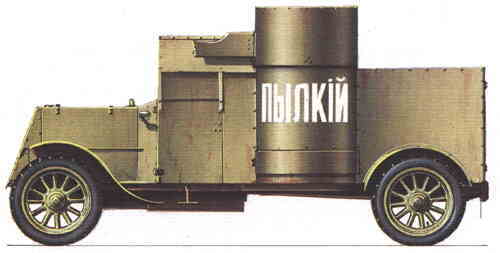 |
Russian Austin of the 2nd series with modifications, 1916. The car has a sign of armoured units on the side.
Drawing by Mikhail Dimitrev [5]. | 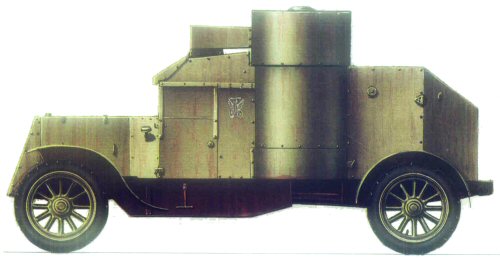 |
Austin of the 3rd series of the Ukrainian Sich Riflemen units, named: "Petlura", winter 1919.
Drawing by Mikhail Dimitrev [5]. | 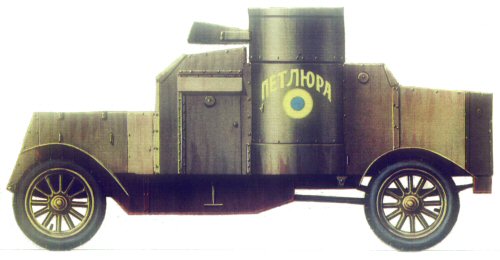
|
Data:
Numbers are approximate in many cases. There happen to be different values in different sources as well. Apart from this, the data could be variable (e.g. the crew).
| Austin I series | Austin II, III series | Austin-Putilov | Austin-Kegresse |
White (Austin I series hull) |
| Crew |
4 | 4/5 | 5 | 5 |
3-4 |
| Combat weight, kg |
2,656 kg (empty,
original armour) | 5,300 kg | 5,200 kg | 5,800 - 5,900 kg |
about 5,500 - 6,000 kg |
|
| | | |
|
| Length |
4.75 m (187 in) | 4.9 m (193 in) | 4.9 m | 6 (or 6.3) m (236/248 in) |
about 5.3 m (208.5 in) |
| Width |
1.95 m (76.8 in) | 2.03 m (79.9 in) | 2 m | 2.13 m |
? |
| Height |
2.4 m (94.5 in) | 2.45 m | 2.58 m (101 in) | 2.68 m (105 in) |
about 2.5 m |
| Wheelbase |
3.5 m (137.7 in) | 3.5m | 3.5 m | - |
3.65 m (143.7 in) |
| Track: |
about 1.5 m (59 in) | about 1.5 m | about 1.5 m | - |
? |
| Ground clearance |
220 mm (8.6 in) | 250 mm | 250 mm | 250 mm |
? |
|
| | | |
|
| Max. road speed |
50-60 km/h | 60 km/h | about 55 km/h | 25 km/h |
about 40-45 km/h |
| Road range |
250 km | 200 km | 200 km | 100 km |
? |
Top of the page
Models
Scale model kits of Austin armoured cars. Names in "quotation marks" are original kits' names, that are not consistent with naming system on this page, or simply wrong. You can write me with comments or additional information.
1/72 [1/76]:
- Modelkrak (Mka-7202) - Austin the 1st series - high quality resin kit of the Polish manufacturer (distributor's page).
- Modelkrak (Mka-7203) - "Russian Austin" - high quality resin kit of Austin-Putilov.
- Extratech (Exm7213) - Austin-Putilov - high quality resin kit with photoetched parts.
- Leva (72-B-02) - Austin-Putilov - resin kit, mediocre quality
- Reviresco (AC-1) - "Austin 1914" - in fact the model is the British Austin the 3rd series (model 1918). All Reviresco models consist of a few white metal parts, but the detail level is for wargamers rather.
- Reviresco (AC-2) - "Russia 1939 Austin" - the vehicle basing on Austin the 3rd series in an alleged 1939 configuration
- Reviresco (AC-7) - Austin-Putilov
- Reviresco (AC-8) - "Austin Putilov halftrack" - Austin-Kegresse
- [25mm] Honourable Lead Boiler Suit Company (HLBS) (GW5) - "British Austin" - Austin model 1918. Though all HLBS resin & metal models are intended for wargamers primarily, but the scale equals to some 1/72 and details look surprisingly nice (despite too big bolts...). Currently seem out of catalogue.
- [25mm] HLBS (GW5a) - "Russian Austin AC (Maxim turrets)" - Austin the 3rd series.
- [25mm] HLBS (GW16) - "Austin-Putilov halftrack" - Austin-Kegresse.
- [25mm] HLBS (GW17) - Austin-Putilov
- [1/76] Cromwell (GW-2) - "Putilov-Austin" - resin kit, nice quality
1/35:
- Armo (35022) - Austin-Putilov - Polish high quality resin + photoetched model.
- Armo (35030) - Austin-Kegresse - Polish excellent resin + photoetched model of Austin-Putilov-Kegresse (be sure to see it at distributor's page).
- Major Models (M.05) - "Austin 1916" - resin and white metal. Strange mix of the British Austin model 1918 (with double rear wheels, Hotchkiss MG's, etc) with Russian-modified rear of Austin the 2nd series in fact...
Sources:
1. M. Baryatinsky, M. Kolomiyetz: "Broneavtomobili Russkoy Armii 1906-1917"; Moscow 2000
2. Janusz Magnuski: "Samochody pancerne Wojska Polskiego 1918-1939"; Warsaw 1993
3. Jan Tarczyński: "Pojazdy w Wojsku Polskim - Polish Army vehicles 1918-1939", Pruszków 1995
4. Fritz Von
Heigl: "Taschenbuch der tanks", 1930.
5. M. Baryatinsky, M. Kolomiyets: "Broneavtomobil 'Ostin'", Bronekollektsiya 1/97
6. Leonard Żyrkiewicz: "Samochody pancerne", W.I.N.-W., 1928
Updates:
- 09. 03. 2010 - minor fixes
- 28. 05. 2007 - Grammar and photo improvements, new photos
- 28. 12. 2004 - Revised, supplemented service after-1917 and pictures
Our Thanks to David Fletcher of the Tank Museum.
Top of the page
[ Main page ] [ Polish armour / armoured cars ]
[ Polish armoured units ] [ Steel Panthers ] [ Links ]
You can mail
me with any questions, comments or photos.
All the photos and pictures remain the property of their owners (although considering their age, most likely the photos are in public domain). They are published in non-commercial educational and research purpose.
Text copyright to Michal Derela © 2000.




















